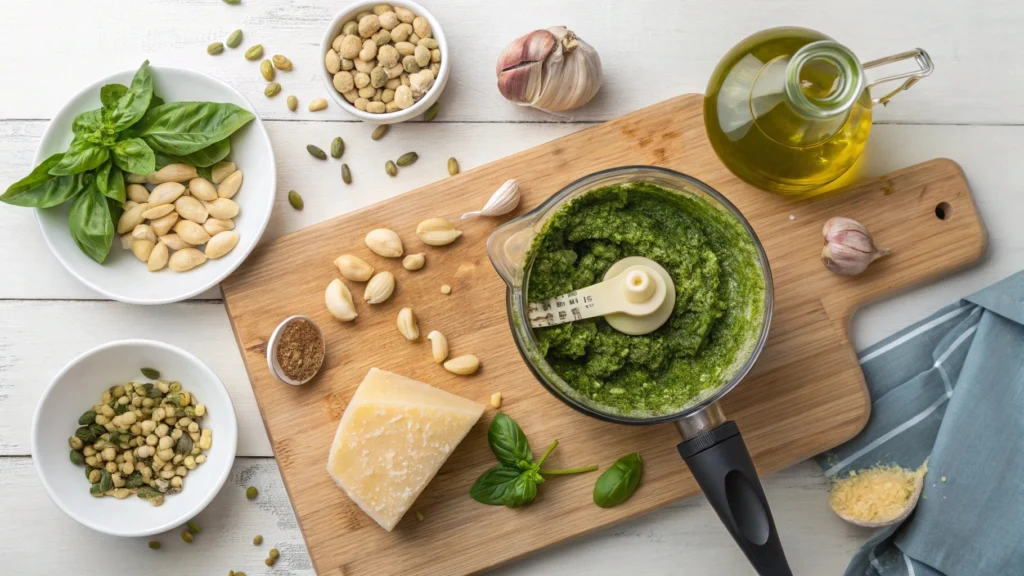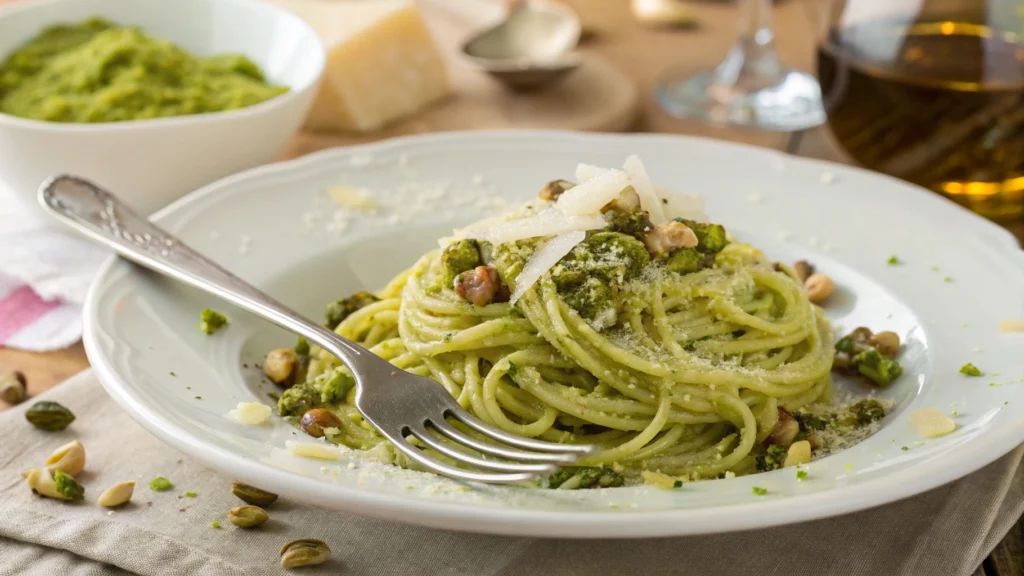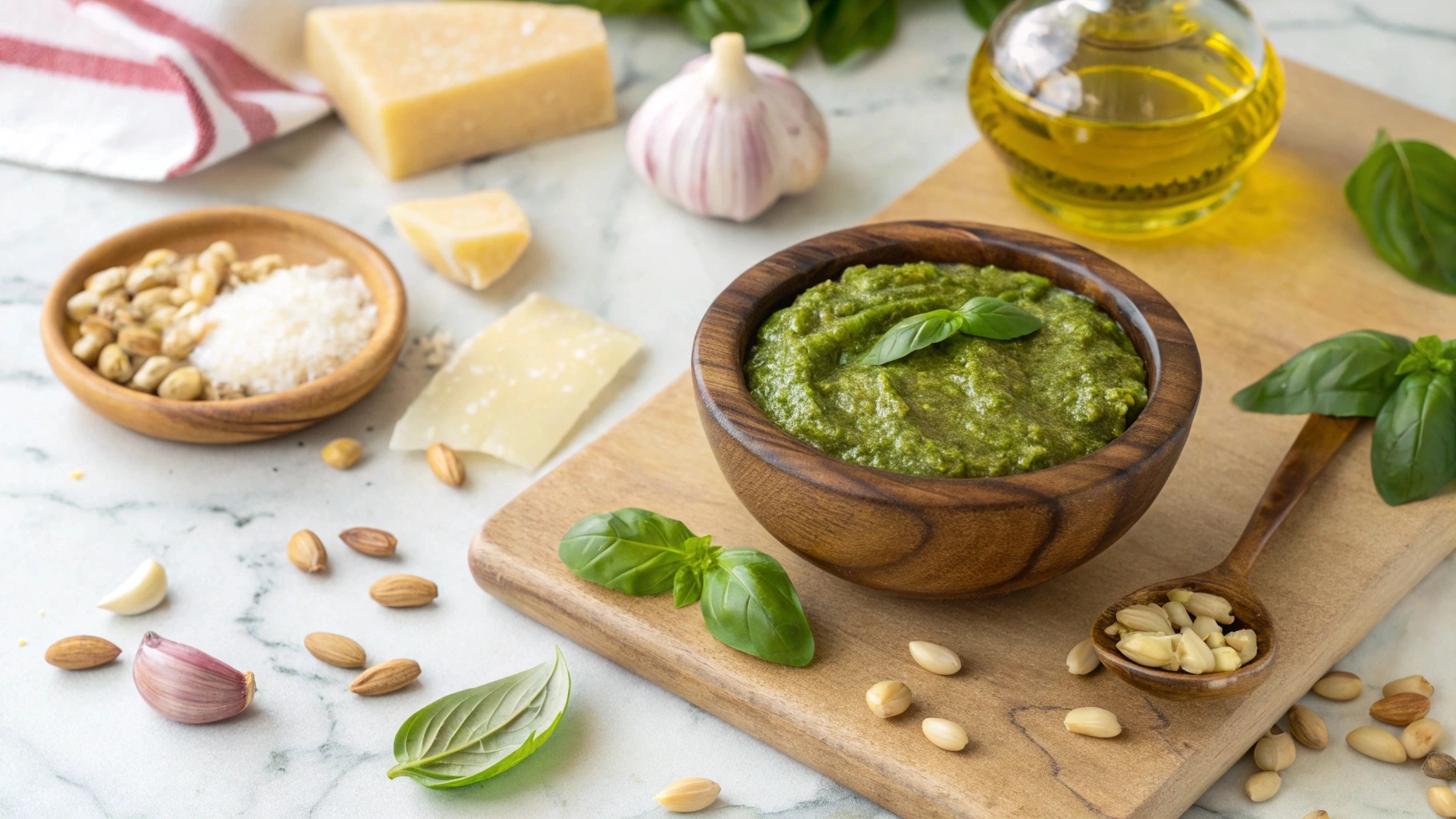Introduction
Pesto lovers, rejoice! There’s a fresh and nutty twist on the classic pesto sauce that’s gaining popularitypistachio pesto. This versatile, vibrant green condiment swaps traditional pine nuts for pistachios, delivering a creamy, slightly sweet flavor that’s perfect for pasta, sandwiches, marinades, and more. In this article, we’ll dive deep into everything you need to know about pistachio pesto, from its ingredients and preparation to its health benefits and creative uses. Whether you’re a seasoned pesto enthusiast or a curious foodie, you’re in for a flavorful journey.
What is Pistachio Pesto?
Origins and Evolution of Pesto
Pesto, derived from the Italian word “pestare” meaning “to pound” or “crush,” has its roots in Liguria, Italy. Traditionally, pesto is made by grinding basil, pine nuts, garlic, Parmesan cheese, and olive oil into a flavorful paste. Over time, chefs and home cooks began experimenting with variations, using alternative nuts, greens, and cheeses to create unique twists.
Pistachio pesto emerged as a modern adaptation, blending the earthy richness of pistachios with the fresh, herbaceous notes of basil. Its unique flavor profile and creamy texture have made it a favorite among culinary enthusiasts seeking a nutty alternative to the classic recipe.
Why Pistachios? A Nutty Twist on Tradition
Why choose pistachios over pine nuts or walnuts? Pistachios bring a slightly sweet, buttery flavor that perfectly complements basil’s aromatic freshness. Their vibrant green hue also enhances the pesto’s visual appeal, making it as stunning as it is delicious. Plus, pistachios are more widely available and often less expensive than pine nuts, offering a practical yet luxurious choice for home cooks.
Additionally, pistachios are packed with nutrients, including protein, healthy fats, and antioxidants, making pistachio pesto not just tasty but also nutritious.
Pistachio Pesto vs. Classic Pesto: Key Differences
At first glance, pistachio pesto and traditional basil pesto may look similar, but their flavors and textures tell a different story:
- Nut Flavor: Pistachios lend a sweeter, less oily taste compared to pine nuts.
- Texture: Pistachio pesto is often creamier and slightly chunkier due to the nut’s natural richness.
- Versatility: While classic pesto leans heavily on its sharp basil and garlic flavors, pistachio pesto offers a more balanced, nut-forward taste that pairs well with a wider variety of dishes.
By swapping just one ingredient, you get a whole new culinary experience. Pistachio pesto retains all the charm of its predecessor while adding an irresistible twist.
Ingredients for Pistachio Pesto
Core Components: Basil, Pistachios, and Cheese

The foundation of a good pistachio pesto starts with a harmonious combination of fresh basil, pistachios, and cheese. Basil provides the classic aromatic and slightly peppery flavor essential to any pesto. Pistachios, with their rich and buttery profile, replace pine nuts to add a unique twist that makes the pesto both creamy and slightly sweet.
For the cheese, Parmesan or Pecorino Romano are traditional choices. Both offer a tangy, salty kick that balances the sweetness of the pistachios and the herbal notes of the basil. Feel free to experiment with alternatives like nutritional yeast for a vegan-friendly option.
The Role of Olive Oil and Garlic in Enhancing Flavors
Olive oil is the lifeblood of any pesto, and pistachio pesto is no exception. Its smooth texture binds the ingredients together while enhancing the richness of the sauce. Extra virgin olive oil is highly recommended for its fruity and slightly peppery notes.
Garlic adds a pungent and zesty edge that cuts through the creamy richness of the nuts and cheese. Adjust the amount to your tastewhether you love a bold garlicky flavor or prefer just a hint of it.
Optional Add-ins: Spinach, Parsley, and Lemon Zest
Want to give your pistachio pesto a personal touch? Add-ins like spinach or parsley can elevate both the flavor and the nutritional profile. Spinach contributes a mild, earthy taste and a vibrant green hue, while parsley adds a fresh, slightly bitter note.
A dash of lemon zest or juice can brighten the sauce, adding a citrusy tang that balances the richness of the nuts and olive oil. These optional ingredients make the pesto even more versatile and customizable to your palate.
Pro Tip: For a related creamy pasta recipe, check out the Creamy Tomato Rigatoni from Timer Recipes for pairing inspiration.
How to Make Pistachio Pesto
Step-by-Step Guide with Tips for Success
Making pistachio pesto is simpler than you think. Here’s how:

- Gather ingredients: basil, shelled pistachios, Parmesan cheese, garlic, olive oil, salt, and pepper.
- In a food processor or blender, pulse the basil, pistachios, garlic, and cheese until roughly combined.
- Slowly drizzle in olive oil while blending, stopping when you reach your desired consistency.
- Season with salt and pepper to taste. Adjust with more oil or a splash of water if the pesto is too thick.
Pro Tip: Toasting the pistachios lightly before blending intensifies their nutty flavor.
Tools You Need: Food Processor or Blender?
A food processor is the traditional choice for making pesto, providing better control over the texture. However, a high-powered blender works just as well, especially if you’re aiming for an ultra-smooth consistency.
For a truly rustic experience, try using a mortar and pestle. It’s a bit more labor-intensive but delivers an authentic, hand-crushed texture and flavor.
Variations: Vegan, Dairy-Free, or Low-Calorie Options
For a vegan-friendly pistachio pesto, substitute the Parmesan cheese with nutritional yeast or vegan Parmesan. If you’re cutting calories, reduce the amount of olive oil and add a bit of water or vegetable broth for a lighter consistency.
A dairy-free version can also be achieved by using almond cheese or omitting the cheese altogether while focusing on enhancing the nutty and herbal flavors. The result? A vibrant sauce that’s just as delicious and versatile.
The Versatility of Pistachio Pesto
Pistachio Pesto as a Sauce for Pasta
One of the most beloved uses for pistachio pesto is as a pasta sauce. Its creamy, nutty flavor coats every strand of spaghetti, rigatoni, or fettuccine beautifully, creating a rich yet fresh dish. To use it as a sauce, simply toss freshly cooked pasta with the pesto and a splash of reserved pasta water. The starch in the water helps create a silky emulsion, enhancing the texture of the sauce.
If you’re feeling adventurous, mix the pistachio pesto with cream or ricotta for an extra indulgent touch. This pairing works exceptionally well with stuffed pastas like ravioli or tortellini.
Creative Uses: Spreads, Marinades, and Toppings
Pistachio pesto isn’t just for pasta! Spread it on toasted bread or crackers for an easy appetizer that will wow your guests. It also makes an excellent topping for roasted vegetables or grilled fish, adding a burst of flavor and vibrant color.
For a unique twist, use pistachio pesto as a marinade. Rub it over chicken or shrimp before grilling or baking to infuse the protein with its rich, nutty essence. You can also drizzle it over pizza or scrambled eggs for a quick, gourmet upgrade.
Pairing Suggestions: Proteins, Veggies, and Wines
The mild sweetness and creaminess of pistachio pesto make it incredibly versatile for pairing. It complements proteins like chicken, salmon, or shrimp beautifully. For vegetarians, it pairs wonderfully with grilled zucchini, roasted red peppers, or sautéed mushrooms.
When it comes to wine, a crisp Sauvignon Blanc or a lightly oaked Chardonnay balances the richness of the pesto. If you prefer red, a light-bodied Pinot Noir works well without overpowering the dish.
Note: For more recipes to enhance your meals, explore the Rigatoni Recipe Guide for complementary pasta inspiration.
Nutritional Benefits of Pistachio Pesto
Pistachios as a Superfood
Pistachios are the star of the show in pistachio pesto, and for good reason. These tiny green gems are packed with protein, healthy fats, and fiber, making them a nutritious addition to any meal. They’re also loaded with antioxidants like lutein and zeaxanthin, which promote eye health.
Unlike many nuts, pistachios are relatively low in calories, making them an ideal choice for those watching their intake without sacrificing flavor or nutrition.
Health Benefits of Basil and Olive Oil
Basil, another key ingredient in pistachio pesto, isn’t just about flavorit’s packed with essential nutrients like vitamin K, which supports bone health, and antioxidants that combat free radicals.
Olive oil, often referred to as a cornerstone of the Mediterranean diet, provides heart-healthy monounsaturated fats and anti-inflammatory properties. Using extra virgin olive oil further amplifies the health benefits, as it retains more antioxidants and nutrients.
Balancing Taste and Nutrition
When you combine pistachios, basil, olive oil, and Parmesan cheese, you get a sauce that’s not only delicious but also nutrient-dense. The healthy fats and fiber in pistachio pesto help keep you full, while the herbs and garlic add anti-inflammatory and immune-boosting properties.
Pro Tip: For a low-calorie variation, reduce the amount of cheese and olive oil, or swap them with lighter alternatives like water or vegetable broth. You’ll still get all the flavor with fewer calories.
Part 6: Frequently Asked Questions About Pistachio Pesto (300 words)
Is pistachio good for pesto?
Absolutely! Pistachios are an excellent choice for pesto, offering a creamy texture and a subtly sweet flavor that complements basil beautifully. Compared to traditional pine nuts, pistachios are more affordable and widely available. Plus, they add a vibrant green hue that makes the sauce visually stunning. The nutty richness of pistachios makes pistachio pesto versatile for various dishes, from pasta to marinades.
Can you substitute pistachios for pine nuts in pesto?
Yes, pistachios can easily replace pine nuts in any pesto recipe. They provide a similar texture but with a sweeter, buttery flavor profile. If you’re experimenting, consider lightly toasting the pistachios before blending to enhance their nutty essence. This substitution not only works for traditional pesto but also for unique variations like kale or parsley-based pestos.
Is pesto unhealthy or healthy?
Pesto, including pistachio pesto, can be incredibly healthy when made with fresh, high-quality ingredients. It’s packed with nutrients like healthy fats from olive oil and pistachios, vitamins from basil, and protein from cheese. However, the calorie count can add up, especially with generous use of cheese and oil. For a lighter version, reduce the oil or substitute it with vegetable broth or water.
What is the best nut for pesto?
While pine nuts are traditional, pistachios are often considered one of the best nuts for pesto. Their creamy texture and sweet flavor create a sauce that’s both rich and balanced. Walnuts, almonds, and cashews are also excellent options, each bringing their unique taste and texture to the table.
Recipe Roundup: Top Pistachio Pesto Creations
Basil and Pistachio Pesto Recipes
The classic pistachio pesto starts with fresh basil, Parmesan, garlic, and olive oil, blended with pistachios for a nutty twist. But don’t stop thereexperiment with Pecorino Romano for a sharper taste or add parsley for a more herbaceous flavor. These variations are perfect for pasta, bread, or even as a dip.
Pistachio Pesto with Spinach or Kale
Adding greens like spinach or kale to your pistachio pesto not only enhances the color but also boosts its nutritional value. These greens blend seamlessly with the basil, creating a milder, less peppery flavor. This variation is ideal for those who prefer a more subtle herbaceous profile.
Unique Flavors: Lemon, Chili Flakes, and More
Take your pistachio pesto to the next level by experimenting with unique flavors. A squeeze of lemon juice adds brightness, while a pinch of chili flakes brings a gentle heat that pairs beautifully with the nutty richness. Other creative add-ins include sun-dried tomatoes, roasted red peppers, or even a splash of white wine for complexity.
Pro Tip: Try drizzling your pistachio pesto over roasted vegetables, grilled meats, or even pizza for a flavor-packed finishing touch. If you’re looking for more culinary ideas, consider exploring unique sauce pairings in Timer Recipes’ extensive collection.
Tips for Storing and Preserving Pistachio Pesto
Refrigeration: How Long Does It Last?
When stored properly, pistachio pesto can stay fresh in the refrigerator for up to 5–7 days. To preserve its vibrant green color and bold flavors, transfer the pesto to an airtight container and cover the surface with a thin layer of olive oil. This simple step prevents oxidation, keeping the sauce fresher for longer.
If you notice the pesto darkening slightly, don’t worry it’s still safe to eat. Simply stir it well before using, and the flavors will remain just as delicious.
Freezing Pistachio Pesto: A Step-by-Step Guide
For longer storage, freezing is the best option. To freeze pistachio pesto, spoon portions into an ice cube tray or small airtight containers. Once frozen, transfer the cubes or portions to a freezer-safe bag, making it easy to grab just what you need.
When you’re ready to use the pesto, thaw it overnight in the refrigerator or warm it gently at room temperature. Freezing may slightly alter the texture, but a quick stir or a splash of olive oil will help restore its creamy consistency.
Avoiding Oxidation: Keeping the Vibrant Green Color
Basil-based sauces like pistachio pesto are prone to losing their bright green hue due to oxidation. To maintain its color, consider blanching the basil leaves briefly before blending. This extra step locks in the vibrant green while preserving the fresh flavor.
Another tip is to always use fresh ingredients and store the pesto away from direct sunlight or heat. Proper handling ensures your pesto looks and tastes its best, no matter how you use it.
Conclusion: A Flavorful Journey with Pistachio Pesto
The Joy of Pistachio Pesto
From its creamy texture to its nutty sweetness, pistachio pesto offers a delightful twist on the classic recipe. Whether you’re tossing it with pasta, spreading it on toast, or using it as a marinade, this versatile sauce elevates any dish it touches.
The simplicity of its ingredients fresh basil, pistachios, garlic, and olive oil makes it both a flavorful and nutritious choice. Plus, its adaptability allows for endless variations to suit every palate and dietary need.
Explore, Experiment, and Enjoy
If you haven’t tried making pistachio pesto yet, now’s the time to start. With these tips and recipes in hand, you’re equipped to create a sauce that’s as versatile as it is delicious. Whether you stick to the classic recipe or explore creative add-ins like spinach or lemon, this pesto promises to impress every time.
For more culinary inspiration, explore Timer Recipes’ collection of sauces and pasta dishes to complement your pesto creations. Let your kitchen become a playground for flavor, and enjoy the endless possibilities this nutty delight has to offer!

